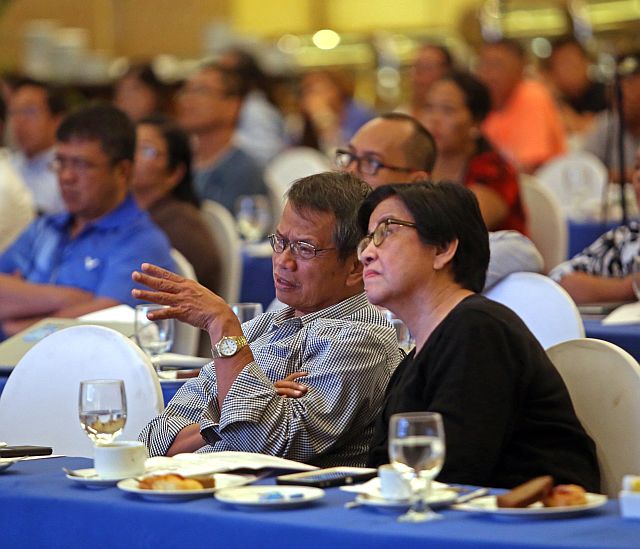Symposium tackles mangroves for coastal defense

DENR Undersecretaries Isabelo Montejo and Sylvia Ordoñez listen to the presentation of mangrove consultant Dexter Cabahug during the symposium on Mangroves for Climate Adaptive and Resilient Communities in Visayas at the Waterfront Cebu City Hotel. (CDN PHOTO/LITO TECSON)
THE importance of mangroves as primary defense against the effects of typhoons and storm surges was emphasized yesterday during the symposium dubbed as Mangrove for Climate – Adaptive and Resilient Communities, attended by at least 200 participants in the Visayas.
The symposium aims to encourage the planting of mangroves and get the participation of the different sectors. Department of Environment and Natural Resources (DENR) Undersecretary Isabelo Montejo, in his speech, said when Super Typhoon Yolanda hit the country in 2013, it was very clear that there was a lack of natural barriers in the coastline like mangroves.
“The communities were hugely devastated by storm surges sending five-meter high, tsunami-like waves. Many families were left homeless, sending thousands of people in complete disarray as evacuation centers were severely damaged,” Montejo said.
From 2013 to 2014, a P1 billion budget was appropriated for mangrove and beach forests development in disaster-risk areas in the Philippines. The budget included areas affected by Yolanda and the 7.2 magnitude earthquake that hit Bohol and Cebu.
DENR-ERDB Director Henry Adornado said that by next year, DENR will target 25,000 hectares of mangrove plantations in the country. For now, there are only 310 hectares planted with mangroves in the entire country.
Adornado said that they want to increase the number of mangroves, which are considered as a first line of defense in coastal areas during a storm surge.
Mangroves anchor on the soil and absorb and dissipate the energy of the waves, slowing their passage inland.
“This is particularly important as high waves or storm tides can quickly erode coastlines and damage structures. Mangroves help clean the air and water along our coastal zones and provide food security and livelihood to the communities,” Montejo said.
The Philippines has 47 true mangrove species and associate species of the 70 species in the world, he added. With mangrove protection, food security in terms of fish catch is assured.
A hectare planted with mangrove trees produces up to 3.6 tons of litter fall annually and one hectare of healthy mangrove ecosystem produces about 1.08 tons of fish per year. Mangroves provide nursery grounds for fish, prawns and crabs, and support fisheries production in coastal waters.
Disclaimer: The comments uploaded on this site do not necessarily represent or reflect the views of management and owner of Cebudailynews. We reserve the right to exclude comments that we deem to be inconsistent with our editorial standards.
